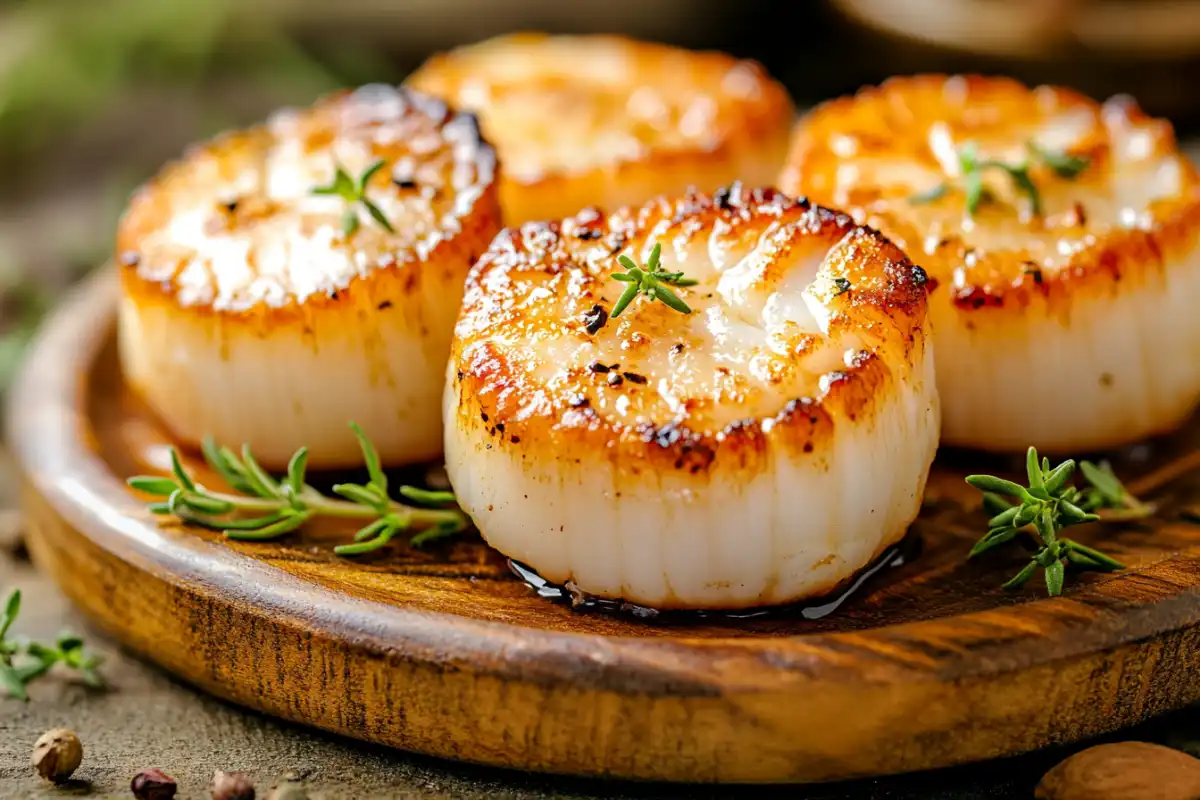Scallops are a delicacy known for their tender, buttery texture and sweet, oceanic flavor. However, many home cooks and chefs swear by a special technique before cooking them—soaking them in milk. But why do you soak scallops in milk before cooking? Does it make them taste better? Does it affect their texture?
In this article, we’ll uncover the science behind soaking scallops in milk, how it enhances their flavor, and why it’s a common trick in professional kitchens. We’ll also explore alternative soaking methods, step-by-step preparation techniques, and expert cooking tips to ensure your scallops turn out perfectly every time.
Introduction to Soaking Scallops in Milk
What Is the Purpose of Soaking Scallops in Milk?
If you’ve ever noticed a fishy smell or slight grittiness in your scallops, you’re not alone. Fresh scallops should have a mild, briny aroma, but sometimes, they develop an unpleasant odor. This is where soaking scallops in milk comes in handy.
Soaking scallops in milk neutralizes any fishy odor, enhances their natural sweetness, and helps tenderize the meat. The milk’s enzymes break down proteins and improve texture, resulting in softer, more succulent scallops.
Additionally, milk helps remove impurities like sand and excess moisture, which can interfere with searing. If you’ve ever had scallops that didn’t get that golden-brown crust, excess water might be the culprit.
Brief History and Origins of This Cooking Practice
While soaking seafood in milk isn’t new, its exact origins are unclear. Many professional chefs and home cooks have long used this technique to improve the quality of fish and shellfish. It’s believed that milk’s casein protein binds to odor-causing compounds, effectively deodorizing the scallops.
This trick is particularly popular in French and American coastal cuisines, where fresh seafood is a staple. Over time, it has become a trusted kitchen hack for anyone who wants to cook restaurant-quality scallops at home.
Why This Method Is Popular Among Chefs and Home Cooks
Many cooking enthusiasts recommend soaking scallops in milk for at least 30 minutes before cooking. Why? Because it:
The Science Behind Soaking Scallops in Milk
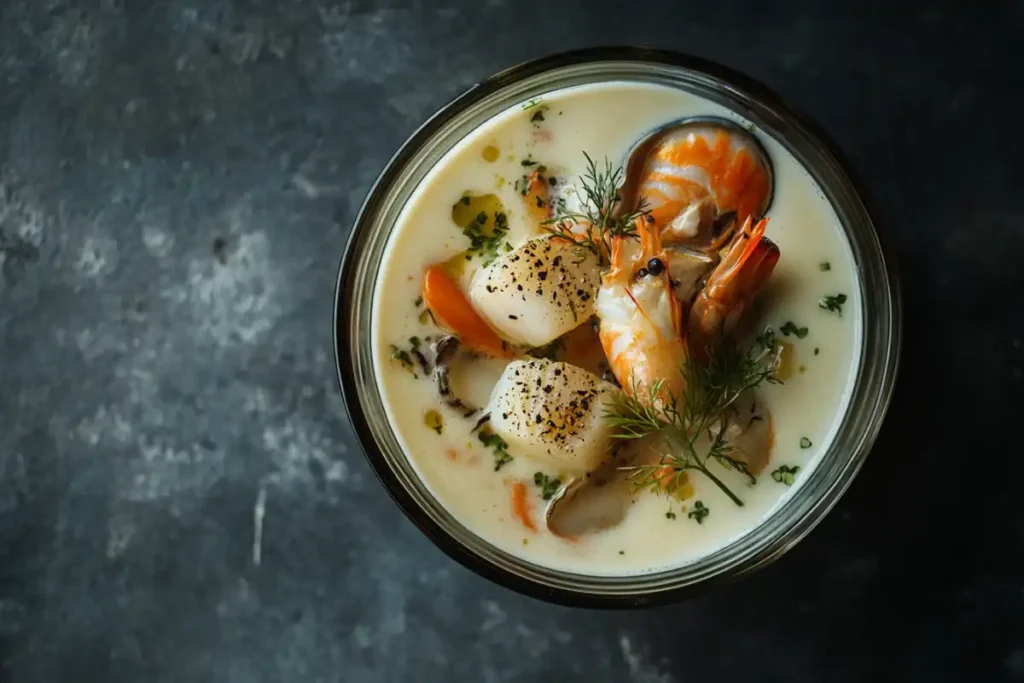
How Milk Neutralizes Fishy Odors
One of the biggest reasons people ask, why do you soak scallops in milk before cooking? is to eliminate the strong, fishy smell. But how does milk actually do this?
Milk contains a protein called casein, which naturally binds to trimethylamine oxide (TMAO)—the compound responsible for that “ocean” smell in seafood. When scallops sit in milk, the casein absorbs and neutralizes these odor-causing molecules, leaving you with fresher-smelling scallops.
This is especially useful for wet-packed scallops, which have been treated with preservatives that sometimes enhance unwanted aromas. Soaking in milk not only removes the fishiness but also enhances the scallops’ sweet, delicate flavor.
How Milk Tenderizes Scallops
Beyond odor control, milk also has a tenderizing effect. The mild acidity in milk breaks down tough proteins in the scallop’s muscle fibers, making them softer and more enjoyable to eat.
While scallops are naturally tender, some can be slightly firm or rubbery if not prepared correctly. By soaking them in milk, you ensure they cook up with a melt-in-your-mouth texture.
How Milk Removes Impurities
Another key benefit? Milk helps clean scallops by drawing out grit, excess moisture, and preservatives. Even if you’ve purchased high-quality scallops, they may still contain tiny bits of sand.
Soaking in milk loosens any trapped grit, making it easier to rinse away before cooking. This simple step ensures that you won’t bite into a grainy scallop—a common mistake that can ruin the dish.
Final Thoughts on the Science of Milk Soaking
So, why do you soak scallops in milk before cooking? It’s all about odor removal, tenderization, and impurity extraction. This technique ensures your scallops cook up perfectly, whether you’re searing, grilling, or sautéing them.
Now that you know the science behind it, let’s move on to how to properly soak scallops in milk for the best results!
Step-by-Step Guide to Soaking Scallops in Milk
Selecting the Right Type of Scallops
Before you start soaking, you need to choose the right scallops. There are two main types:
- Dry-Packed Scallops – The best option! These are natural and free from preservatives.
- Wet-Packed Scallops – Often treated with sodium tripolyphosphate (STPP), which adds moisture but can make scallops rubbery.
If you’re using wet-packed scallops, soaking in milk becomes even more important, as it helps remove some of the chemical aftertaste.
For a complete guide on how to cook restaurant-quality scallops, check out this salmon and scallops recipe from Zappy Recipes.
How Long Should You Soak Scallops in Milk?
Time matters! Here’s a simple breakdown of soaking durations:
- 20-30 minutes – Just enough time to remove odors and impurities.
- 1 hour – Ideal for extra tenderization, especially for firmer scallops.
- Over 2 hours – Not recommended! Extended soaking can make scallops too soft.
Always keep the scallops refrigerated while soaking to maintain freshness.
Best Practices for Rinsing and Patting Dry
After soaking, drain the milk and rinse the scallops under cold water. This removes any remaining residue and ensures they cook properly.
Next, pat them dry with a paper towel. This is crucial for getting that golden-brown sear when cooking. Wet scallops won’t caramelize properly in the pan!
Key Takeaways
- Always choose dry-packed scallops when possible.
- Soak for 20-30 minutes for best results.
- Rinse and dry thoroughly to ensure a perfect sear.
Comparing Soaking Methods: Milk vs. Other Liquids
Why Do You Soak Scallops in Milk Before Cooking Instead of Other Liquids?
Soaking scallops in milk is a popular technique, but some cooks wonder if other liquids work just as well—or even better. While milk is effective for removing fishy odors, tenderizing, and cleaning scallops, let’s compare it to other soaking methods.
Milk vs. Buttermilk
Buttermilk is slightly more acidic than regular milk, which means it tenderizes scallops more aggressively. This can be beneficial for tougher scallops but might make delicate ones too soft. Buttermilk also has a tangy taste, which can alter the scallops’ natural sweetness.
Milk vs. Lemon Juice or Vinegar
Lemon juice and vinegar are both highly acidic, which makes them excellent for removing odors. However, they can firm up the scallops too much by overcoagulating the proteins, making them chewy instead of tender.
Milk vs. Salted Water
A saltwater soak is a common alternative, especially for those who want to enhance the scallops’ briny taste. While it doesn’t neutralize odors as well as milk, it helps maintain moisture and improves texture.
Which Soaking Method Is Best?
If your goal is to remove unwanted smells, tenderize scallops, and preserve their natural sweetness, milk remains the best choice. Other liquids may work for specific needs, but milk offers the best balance of benefits without altering the scallops’ flavor too much.
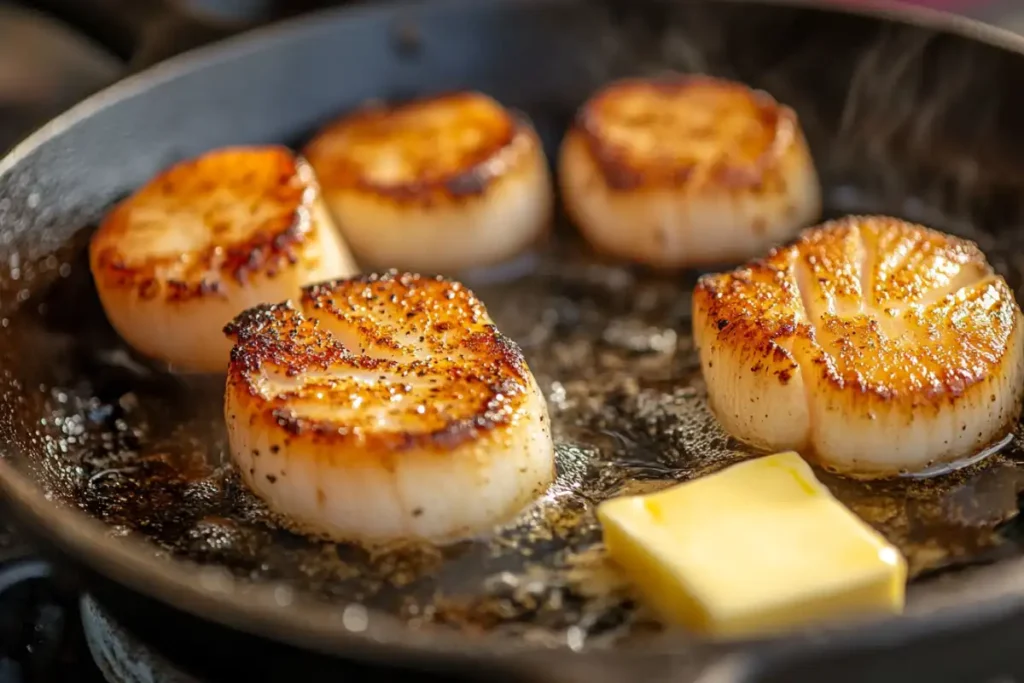
How to Achieve the Perfect Sear After Soaking
Once your scallops have been soaked in milk, rinsed, and patted dry, it’s time to cook them. A golden-brown crust with a tender, buttery interior is the goal, and achieving it requires a few key steps:
- Use a very hot pan – A cast-iron or stainless-steel pan works best for even heat distribution.
- Use high-smoke-point oil – Avocado, grapeseed, or canola oil ensures a good sear without burning.
- Space them out – Overcrowding the pan causes steaming instead of searing.
- Let them cook undisturbed – Sear each side for 1.5 to 2 minutes before flipping.
Oil vs. Butter: Which One Is Better for Cooking Scallops?
Many people debate whether scallops should be cooked in oil or butter. Here’s the truth:
- Oil is essential for the searing process because it prevents burning and allows for high-heat cooking.
- Butter adds flavor but burns easily, so it’s best to add it at the end of cooking.
Common Mistakes to Avoid When Cooking Scallops
Even after soaking, people make these common mistakes when cooking scallops:
❌ Skipping the drying step – Excess moisture prevents a proper sear.
❌ Flipping too soon – Let the scallops develop a crust before flipping.
❌ Overcooking – Scallops should be slightly translucent in the center when removed from the heat.
Final Tips for Cooking Soaked Scallops
By now, you know the answer to why do you soak scallops in milk before cooking?—it’s all about better texture, flavor, and odor removal. But proper cooking is just as important!
For a delicious scallop dish, check out this restaurant-quality salmon and scallops recipe for more inspiration!
The Impact on Flavor and Texture
How Soaking Enhances the Natural Sweetness of Scallops
One of the main reasons people ask, why do you soak scallops in milk before cooking? is because they want to enhance the delicate, natural sweetness of scallops.
Scallops have a mild, buttery flavor, but sometimes they can have a slight fishy taste—especially if they’ve been stored for a while. Soaking in milk helps remove unwanted odors without overpowering their natural sweetness. The mild acidity in milk balances and refines the flavor, ensuring that every bite is smooth, sweet, and fresh.
Texture Differences Between Soaked and Unsoaked Scallops
Soaking scallops in milk doesn’t just improve taste—it also affects texture. A properly soaked scallop will be softer and more tender than one that hasn’t been treated.
Here’s how soaking makes a difference:
- Unsoaked scallops may feel slightly firm or rubbery, especially if they’re wet-packed and have absorbed extra moisture.
- Milk-soaked scallops break down excess muscle fibers, creating a melt-in-your-mouth texture that’s perfect for searing or grilling.
Does Soaking Affect Cooking Times?
Soaking scallops in milk doesn’t significantly change cooking times, but it does ensure even cooking. Since milk removes excess moisture and tenderizes the flesh, scallops cook more uniformly, preventing some from being chewy while others overcook.
The result? Scallops that are consistently soft inside with a perfectly caramelized crust on the outside.
Now that we understand the flavor and texture benefits, let’s clear up some common myths and misconceptions about soaking scallops in milk.
Common Myths and Misconceptions About Soaking Scallops
Does Soaking in Milk Make Scallops Mushy?
A common misconception is that soaking scallops in milk makes them too soft or mushy. However, this only happens if they are soaked for too long.
To avoid this:
- Stick to a 20-30 minute soak—this is enough time to remove fishy odors and improve texture without making them overly soft.
- Avoid leaving them in milk for hours, as excessive soaking can break down too many proteins and lead to a loss of firmness.
Do All Scallops Need to Be Soaked?
Not necessarily! High-quality, dry-packed scallops usually don’t need to be soaked, as they’re naturally fresh and free from preservatives. However, wet-packed scallops (which are treated with preservatives like sodium tripolyphosphate) benefit greatly from a milk soak.
Can You Use Non-Dairy Alternatives?
Some people wonder if they can use plant-based milk alternatives instead of regular milk. The short answer? It depends on the type of milk.
- Coconut milk can add a light sweetness but won’t neutralize odors as effectively.
- Almond and soy milk lack the casein protein needed to bind with odor compounds, making them less effective.
- Buttermilk is the best alternative, as it contains natural enzymes that help tenderize seafood.
Final Thoughts on Soaking Myths
If you’re still wondering, why do you soak scallops in milk before cooking?, the answer is clear: it enhances flavor, improves texture, and eliminates unwanted odors. It’s a simple trick that takes scallop dishes to the next level!
Next, we’ll answer some of the most frequently asked questions about preparing and cooking scallops. Stay tuned!
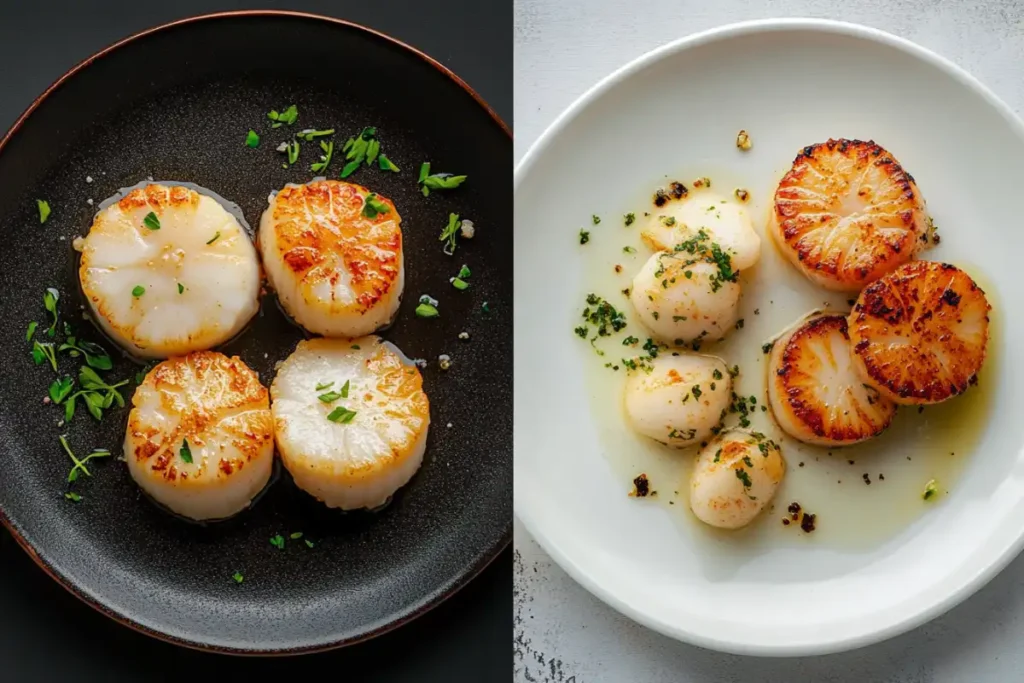
Frequently Asked Questions
Many home cooks still have questions about preparing scallops, especially when it comes to soaking them in milk. Below, we answer some of the most common FAQs about this technique and the best ways to cook scallops.
What Is the Secret to Perfect Scallops?
The key to perfectly cooked scallops comes down to three simple steps:
Use high-quality scallops – Dry-packed scallops are the best choice. If you’re using wet-packed ones, a milk soak improves their texture and flavor.
Ensure they are dry before cooking – After soaking, pat them dry thoroughly. Excess moisture prevents proper searing.
Sear them over high heat – A hot pan, the right amount of oil, and a quick sear (1.5 to 2 minutes per side) give scallops a golden-brown crust while keeping them tender inside.
What Happens If You Don’t Rinse Scallops Before Cooking?
Not rinsing your scallops can leave behind residual milk, sand, or preservatives, which may affect their flavor and texture. Always rinse them under cold water after soaking to remove any lingering impurities, then pat them dry before cooking.
What Not to Do When Cooking Scallops?
Here are some of the most common mistakes to avoid:
Overcrowding the pan – Too many scallops in the pan cause them to steam instead of sear.
Using low heat – Scallops need high heat to get that crispy crust.
Overcooking – They should be slightly translucent in the center when removed from the pan. Overcooked scallops turn rubbery.
Should Scallops Be Cooked in Butter or Oil?
A combination of both is best! Start with oil (since it has a high smoke point) to get a great sear, then finish with butter to enhance flavor. Adding garlic or fresh herbs at the end creates a delicious, restaurant-quality scallop dish.
Now that we’ve covered the most common questions, let’s wrap up with final thoughts on why soaking scallops in milk is a game-changer!
Conclusion – Why Do You Soak Scallops in Milk Before Cooking?
So, why do you soak scallops in milk before cooking? The answer lies in its ability to neutralize fishy odors, tenderize the texture, and remove impurities. This simple step can take your scallops from average to outstanding!
By using milk, you ensure that your scallops:
✅ Taste fresher by eliminating any unwanted fishy smell.
✅ Cook more evenly with a softer, more delicate texture.
✅ Develop a better sear by reducing excess moisture.
While other soaking methods exist, milk remains the best all-around option because it enhances flavor without altering the scallops’ natural sweetness.
If you’ve never tried soaking scallops in milk before, give it a shot! You’ll notice the difference in both taste and texture, making your scallop dishes even more impressive.
Print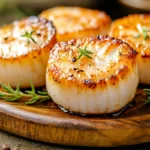
Why Do You Soak Scallops in Milk Before Cooking?
- Total Time: TT35M
- Yield: 2 servings 1x
Description
These seared scallops are soaked in milk before cooking, which helps remove fishy odors, enhances their natural sweetness, and ensures a tender, melt-in-your-mouth texture. With a perfect golden-brown crust and buttery finish, this dish is quick, easy, and restaurant-quality!
Ingredients
- 12 large sea scallops (preferably dry-packed)
- 1 cup whole milk (for soaking)
- 2 tbsp olive oil (or avocado oil)
- 2 tbsp unsalted butter
- 2 cloves garlic, minced
- ½ tsp sea salt
- ¼ tsp black pepper
- ½ tsp smoked paprika (optional, for extra flavor)
- 1 tbsp fresh lemon juice
- Chopped parsley or chives (for garnish)
Instructions
- Soak the scallops: Place the scallops in a bowl and cover with milk. Let them soak in the refrigerator for 20–30 minutes.
- Rinse and dry: Drain the milk, rinse the scallops under cold water, and pat them completely dry with a paper towel.
- Season: Lightly season with salt, pepper, and paprika on both sides.
- Preheat the pan: Heat a cast-iron or stainless steel pan over medium-high heat. Add olive oil and let it get hot.
- Sear the scallops: Place scallops in the pan, making sure they don’t touch. Sear for 1.5–2 minutes per side until golden brown.
- Finish with butter and garlic: Add butter and minced garlic to the pan, spooning the butter over the scallops for added flavor.
- Serve immediately: Drizzle with lemon juice, garnish with chopped parsley, and serve hot.
Notes
- Use dry-packed scallops for the best texture. If using wet-packed, soaking in milk is essential.
- Don’t overcrowd the pan—scallops need space to develop a crispy crust.
- If scallops stick to the pan, they’re not ready to flip yet—wait until they release naturally.
- Prep Time: PT30M
- Cook Time: CT30M
- Category: Dinner
- Method: Searing
- Cuisine: American, French
Nutrition
- Serving Size: 6 scallops
- Calories: 280 kcal
- Sugar: 1g
- Sodium: 320mg
- Fat: 18g
- Saturated Fat: 6g
- Unsaturated Fat: 10g
- Trans Fat: 0g
- Carbohydrates: 3g
- Fiber: 0g
- Protein: 25g
- Cholesterol: 55mg
Keywords: seared scallops recipe, how to cook scallops, milk-soaked scallops, why do you soak scallops in milk before cooking, best scallop cooking tips, seafood dinner recipes

